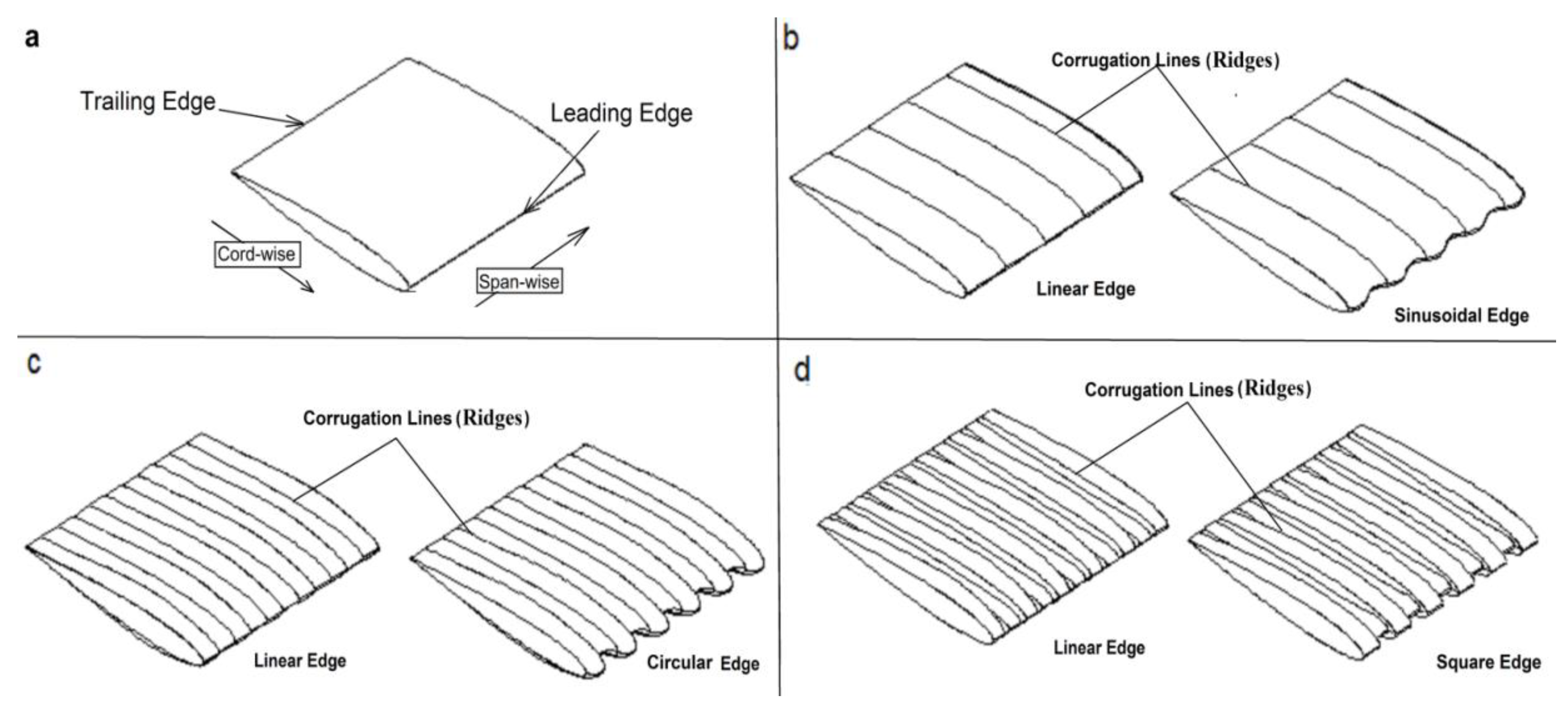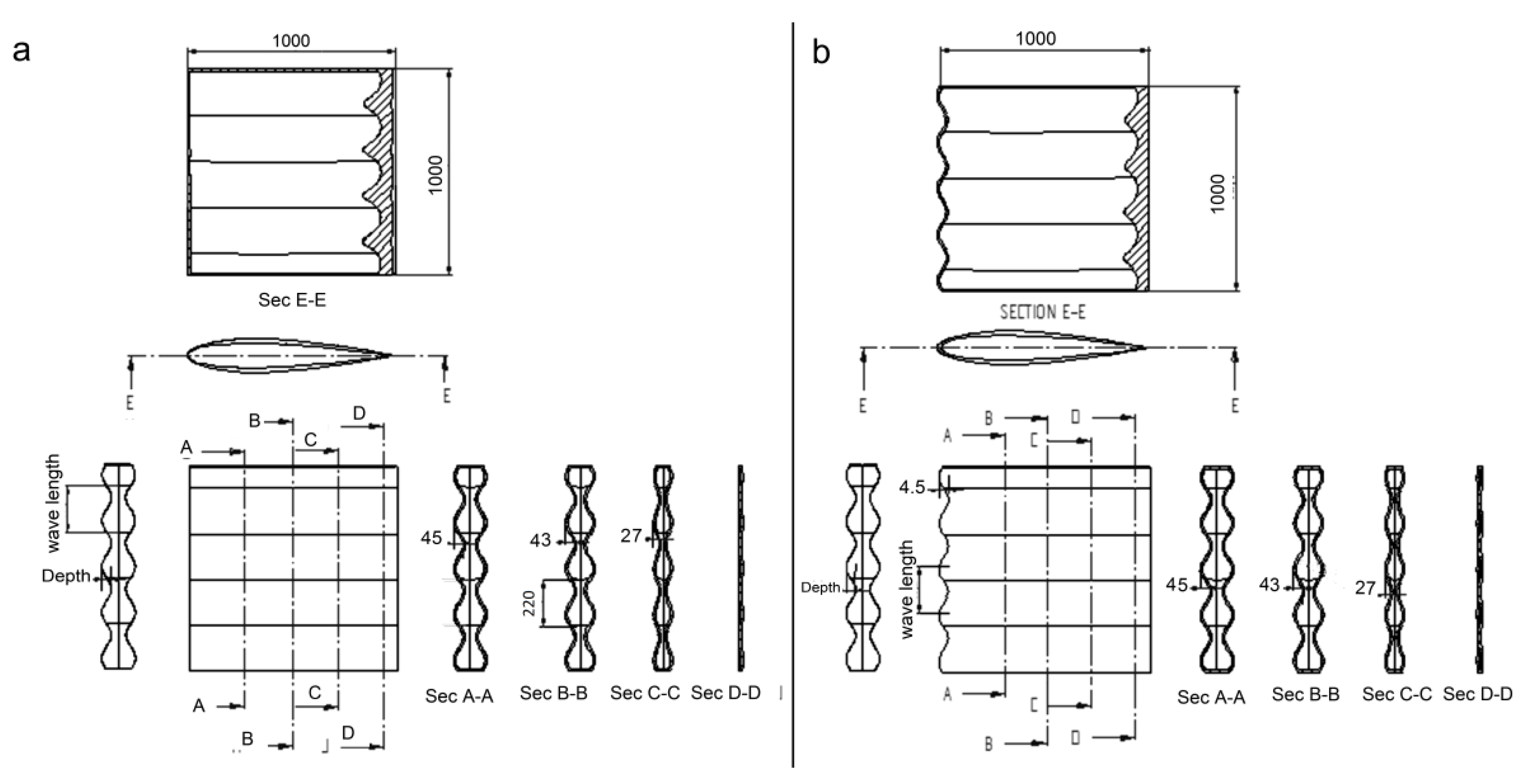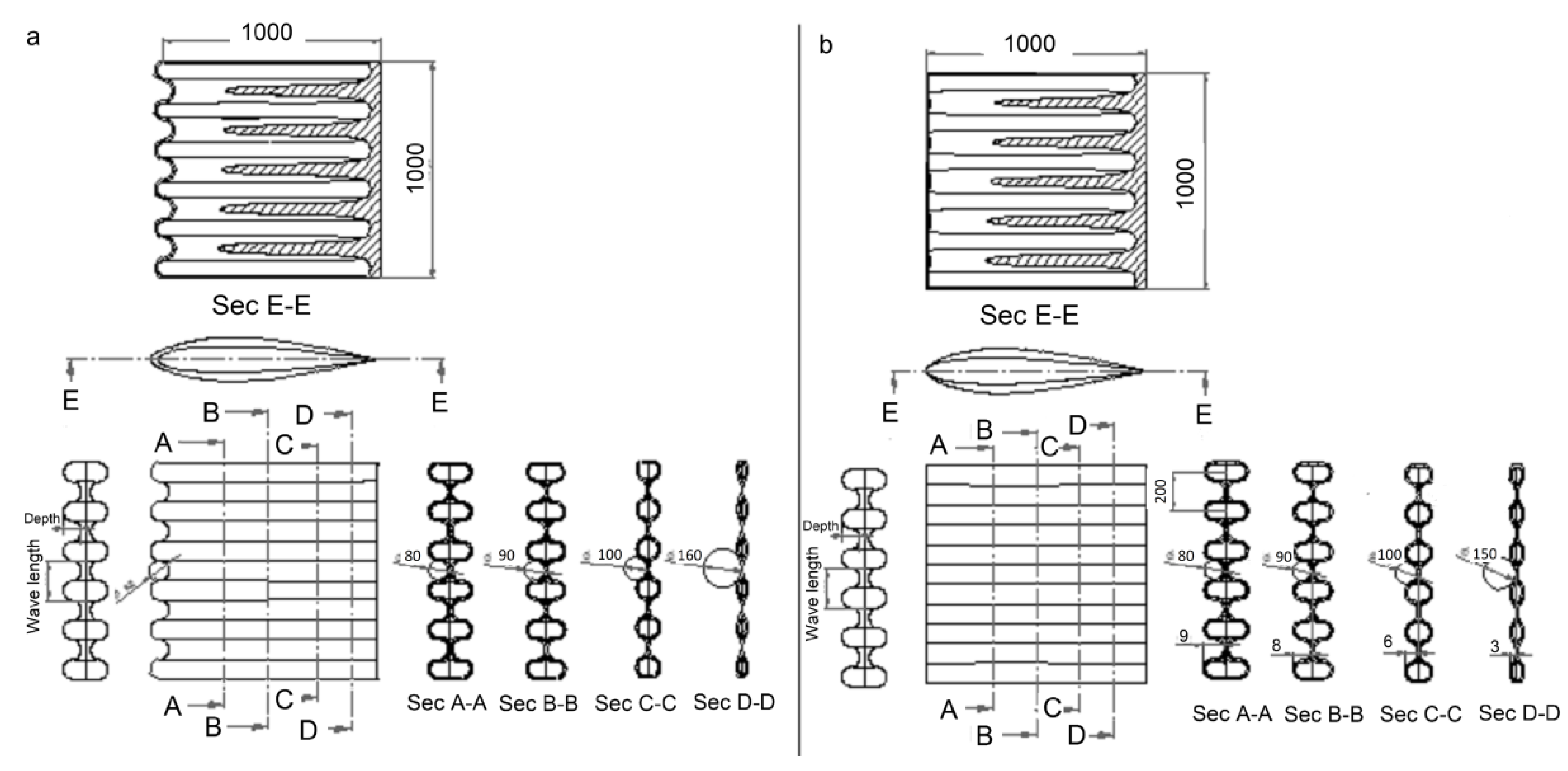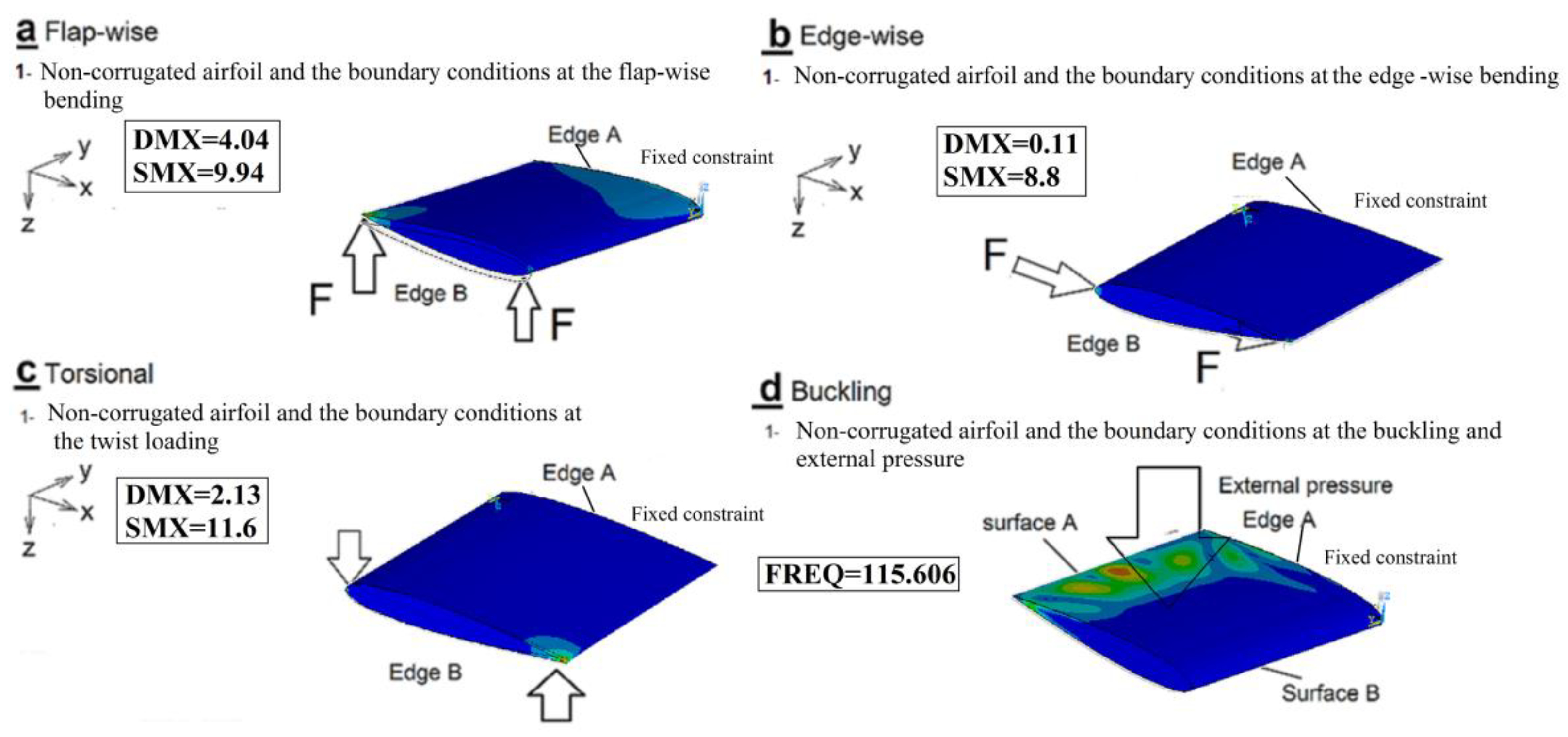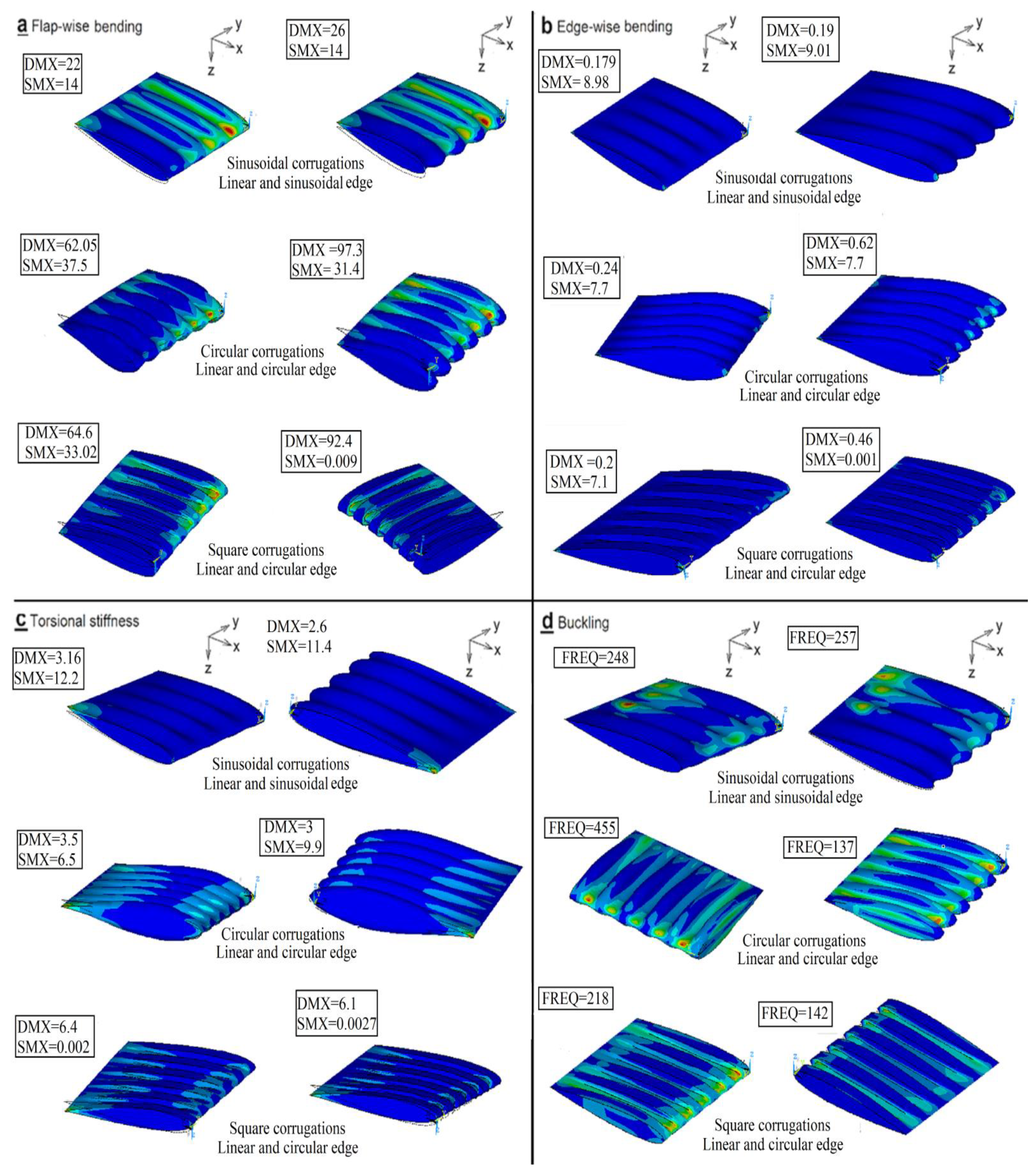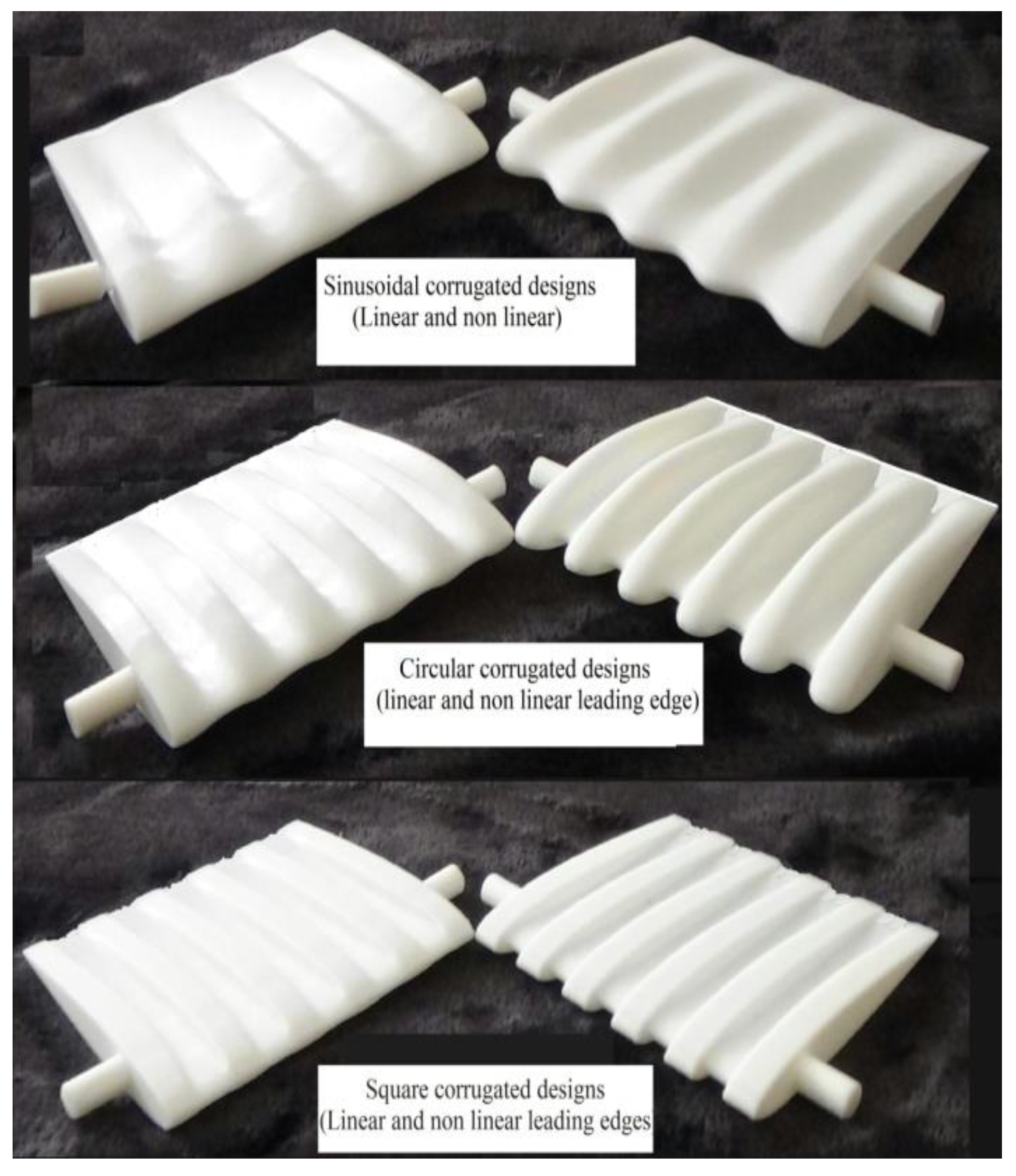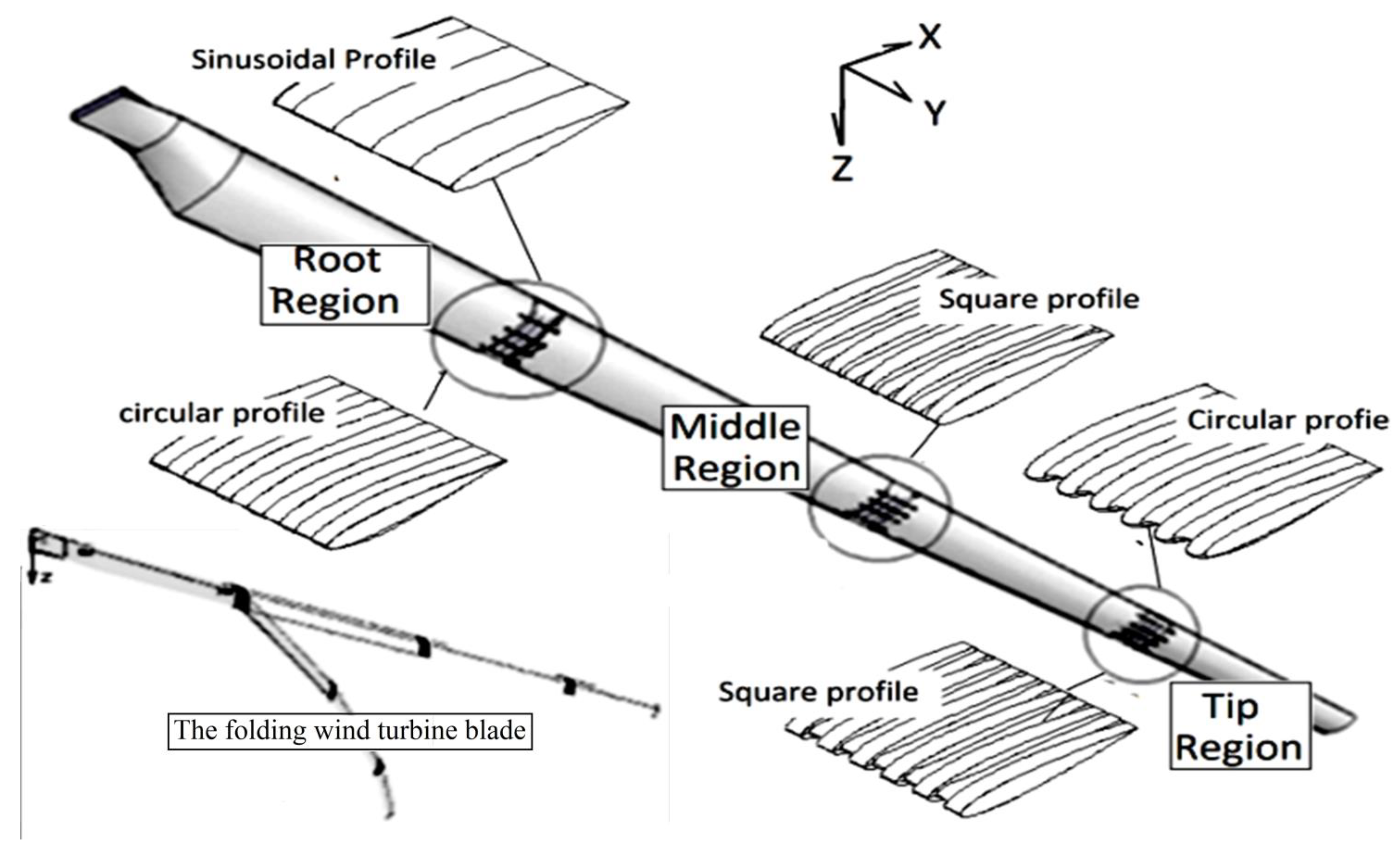1. Introduction
Folding wings, variable-span (telescoping) wings, adapting airfoil, and deployable wings are recent morphing technology to enhance the aerodynamics performance that depends on the wing shape [
1]. Generating adequate thrust and lifting force to overcome the drag resistance and gravity is the main objective according to the missions and flight conditions [
1]. Besides, alleviating stresses and aerodynamic braking of the gigantic wind turbine blade are other roles of the morphing technology by replacing the stiff parts with more compliant structures [
2].
Morphing technologies based on smart materials and corrugated structures will be required to enable an aircraft to perform in-flight configuration changes for optimum performance [
3]. The corrugated structures attain the previous aim for flexing and deforming the wing skin. They distinguish with anisotropic behavior that is stiff along the corrugations direction, but flexible in the transverse direction [
4].
The morphing of wings and wind turbine blades can be classified into two main groups, in-plane morphing and out-of-plane morphing [
2]. The morphing degree can be classified as large, medium, or small depending on the dimensions that vary [
1]. Reference [
5] presented NACA0012 airfoil with different sized corrugated profile along the cord-wise direction and tested aerodynamics performance. The corrugations reduced the lift-curve slope and lift-drag ratio. By increasing the Reynolds number, there were slightly larger lift curve slopes.
The corrugations along the span-wise direction were a solution for wing span morphing due to extremely anisotropic behavior, allowing flexibility in the spanwise/morphing direction while maintaining sufficient stiffness in other directions. Thus, the actuator deforms the wing span, reducing the span on the ground for load alleviation or increasing the span length to enhance the aerodynamics during flight [
6].
The pitch distance, sheet thickness, and corrugations height are the main geometrical parameters of the corrugations that impact the morphing [
1]. Therefore, optimization was used to verify the influence of corrugations height and the angle on the morphing displacement.
In nature, a number of insects including locusts, dragonflies, and damselflies use corrugated wings that do not appear to be very suitable for flight [
4]. But, researchers found that negative pressure would be produced at the valleys of the corrugated dragonfly wing model, which would contribute to the increased lift [
7]. The corrugated dragonfly airfoil had much better performance over the streamlined airfoil and the flat plate at low Reynolds number level [
8]. Along the transverse direction of the wavy corrugations enables the insect wing to sustain the aerodynamics and inertial loads [
1]. The humpback whale’s flippers have certain projections called tubercles which help it to delay flow separation while performing tight underwater maneuvers and their leading edges follow sinusoidal patterns [
9].
The anthropomorphic wind turbine blade motivates the author to present various designs of flexure hinges. Each region of this blade had a flexure hinge, at the tip, mid-span, and root enabling the blade to fold as the natural finger during transportation. When the wind turbine blade reaches to site, the flexure hinges are reinforced with the wires [
10].
The method section of the study describes the full detail design of the introduced flexure hinges. The sinusoidal, circular and rectangular profiles of the corrugations are selected and swept along NACA0012 to form the flexure hinges. The main geometrical parameters of the corrugations are inspired from tubercles of whales.
The finite element method modeling section investigates the mechanical strength of the flexure hinge designs. The Flap-wise, edge-wise, torsional stiffness and the buckling resistance are estimated. The study fabricates scaled samples by rapid prototyping. Accordingly, the following sections assign the best fit corrugation profile for each region of the wind turbine blade to sustain the operating conditions.
2. Description of the Flexure Hinge Designs
In this section, there are three different flexure hinge designs that are based on an airfoil NACA0012. Changing the profile geometry of the corrugations and leading edges is the main design attributes of the introduced designs as shown in
Figure 1.
NACA0012 airfoil is a symmetric airfoil and the most used airfoil in researches and applications.
Figure 1a illustrates NACA0012 and the leading and trailing edges, in span-wise and cord-wise directions.
Figure 1b–d verifies three main flexure hinge designs with different profiles. Sinusoidal, circular, and square represent the profile geometries of the corrugations. Each design has two configurations, linear and corrugated leading edges. Their chord length, a straight line from the leading edge to the trailing edge of the airfoil, is 1000 mm. Meanwhile, the span is 1000 mm.
In addition, this section covers the full detail design of each flexure hinge design that includes the number of corrugate or the pitch distances and the depth. The finite element simulations of each design are investigated to define the edge-wise, flap-wise, and torsional stiffness and the buckling resistance.
2.1. Sinusoidal Corrugated Design
Figure 2 illustrates the flexure hinge design that bases on the sinusoidal profile geometry. The amplitude or corrugation depth and wavelength of the design are inspired by the wavy shape of tubercles. The amplitude to chord and the wavelength to chord ratios are 0.025, 0.2 respectively. These ratios represent the optimum values of the sinusoidal pattern of the tubercles [
9] and will be applied to the sinusoidal profile of the corrugation, the amplitude, and wavelength, reflected on the depth and the number of corrugations, as shown
Figure 2. The corrugations direction is along the span-wise of the NACA0012 and the sinusoidal profile follows the ratios of tubercles.
Figure 2a,b illustrates the geometry of the leading edges, linear and sinusoidal. According to the inspiration from the tubercle, the wavelength or pitch distance does not exceed 200mm, along the cord-wise, the corrugations depths vary as shown in
Figure 2. To show the interior details in the design, there are sections at the cutting planes (A-A), (B-B), (C-C), (D-D), and (E-E).
The inspired optimum ratios situate at the airfoil apex as shown in Sec-A-A. Toward the trailing edge, Sec (B-B, C-C) verifies the gradual decreasing of the corrugations depth. At the sinusoidal edge configuration, the optimum ratios are located at the leading edge and the airfoil apex as shown in
Figure 2b. The interior structure and the hollow cavity of the designs are illustrated by sec (E-E).
2.2. Circular Corrugated Flexure Hinges Design
Figure 3 illustrates the flexure hinge designs based on the circular corrugated geometry. The main parameters of the circular profile are the wavelength and radius instead of amplitude as the sinusoidal profile. Thus, the diameter to chord and the wavelength to chord ratios are 0.025, 0.2 respectively. There are two configurations, linear and circular leading edges as shown in
Figure 3a,b. The pitch distance or wavelength is 200 mm. The maximum depth or height of the corrugations at the airfoil apex is 90 mm. The diameter of the circular profile increases gradually from the apex to the trailing edge as shown in sec (A-A, B-B, C-C). The views of the sections E-E verify the interior structure of the circular corrugation designs.
2.3. Square Corrugated Flexure Hinge Design
The third design of the flexure hinge bases on the square corrugation as shown in
Figure 4. The main geometrical parameters, number of corrugations, the width and depth of corrugation along the span-wise are investigated in
Figure 4.
Figure 4a,b illustrates geometries of edges. The ridges of the corrugates are suggested to be have fillet radius not exceeding1 mm to avoid stress concentration. The depth to chord and the wavelength or pitch distance to chord ratios are 0.025, 0.2 respectively.
The depth of the square corrugation varies along the chord-wise direction and decreases until minimized at the trailing edge as shown in
Figure 4a,b. The widths of the square corrugation increase at the airfoil edges while the depth decreases as shown in
Figure 4b, sec (A-A, B-B, C-C). The views of section E-E demonstrate the interior structure of the design.
5. Discussion
On the contrary to the previous morphing technologies, the morphology in this study does not relate to or enhance the aerodynamics performance. Folding the blade along span-wise according to the road turns and reducing the transport cost are the morphing objectives. It will be classified as out of plane morphing and large degree of the morph. When the anthropomorphic wind turbine blade arrives at the windy site, workers reinforce the flexure hinges with wires to raise the flap-wise stiffness and sustain the cyclic and fatigue loadings [
9]. The three corrugated flexure hinges of the blade represent a small fraction of the whole span as shown in
Figure 8. So the study did not consider the aerodynamics effect because the total effective area of the three corrugated flexure hinges represents a very small fraction not exceeding 5%.
In order to serve the anthropomorphic wind turbine, the study presented different designs to enhance the folding along span-wise and sustain the loading conditions. The designs are based on the corrugation with different profiles and leading edges, sinusoidal, circular, and rectangular. To devise the corrugated flexure hinges, the selected profiles were swept along NACA0012 that represented the most extensively used airfoil in research. The other type of NACAs could be utilized in the same methodology to design the corrugated airfoil.
The saw tooth or triangular profile is not covered in this study due to the lowest ultimate deformation and strain compared to the other profiles [
17]. Meanwhile, the higher extreme anisotropic behavior and lower effective longitudinal flexural stiffness of the rectangular, sinusoidal, and circular profiles guarantee the higher flexibility and the larger morphing at the span-wise direction [
18]. Consequently, the study found the selected profiles are good candidates for the folding wind turbine blades.
The main geometrical parameters of the corrugations are inspired from the tubercle of the whales. The amplitude and the wavelength of the sinusoidal profile and the leading edge resembled the optimum values of the wavy shape of the tubercles and reflected on the number and the depth of corrugations. The other corrugated flexure hinge designs have the same number of corrugations. Comparing to the corrugated skins of the wings [
1], the introduced designs have higher corrugated depths that change along the chord-wise direction.
Selecting the most suit corrugated flexure hinge designs depends on crucial strength characteristics of the blade regions through the operation such as stiffness and buckling. Therefore, the study focused on flap-wise, edge-wise, and torsional stiffness to sustain the bending and gravity loads. Due to the buckling possibility at the high chord and span to thickness ratio regions of the blade, the study evaluated the buckling resistance for each deign when sustains external pressure.
The finite element method is the tool used to demonstrate the stiffness and the buckling eigen-values of the flexure hinge designs. The finite element results investigated the effect of the corrugation profile and the shape of the leading edges on the mechanical behaviors. The study focused on the profile type effect on the mechanical strength and did not consider the material. Thus, the used material in the model is plastic, being the closest material to the filament of the 3d printer; nevertheless it is not common using in the wind turbine industry. According to the aspect ratio, the meshing quality is sufficient. The selected quadratic element size gives us optimal combination between of accuracy and computing time [
19].
The boundary conditions arrangement and the selected values of the applied loads of the models cohere to the unit load condition that was used to evaluate the static deflection of the wind turbine blade [
13].
The corrugation process enhanced buckling resistance considerably instead of using sandwich structure or inherent directional properties of the composite material that represent the effective methods in wind turbine blade [
20].
The introduced designs with linear leading edges have higher edgewise stiffness. The shape of edges affected slightly on torsional stiffness. While, along corrugations direction, flap-wise stiffness decreased.
In the case of sinusoidal corrugations design, the geometry of leading edge does not affect the Eigen-values of buckling noticeably. The circular profile with the linear leading edge had the highest buckling resistance. When using the circular edge, the flap-wise and edge-wise stiffness decreased drastically. Minimizing twist stiffness is achieved by square corrugations design.
At root region that sustains from higher gravity and buckling possibility, the sinusoidal and circular-corrugated designs with linear edge are recommended due to having higher edge and twist stiffness and buckling resistance. Decreasing the gravity loads and the augmenting the possibility of buckling at the mid-span (middle) region induce the study to select the square corrugation design with linear leading edge. The flap-wise, edge-wise, and torsional stiffness of the blade decreased hugely at the tip of the blade [
13]. Consequently, the square and circular corrugated with non-linear leading edge are selected.
Figure 8 illustrates the location of the best suit profiles at the anthropomorphic wind turbine blade [
10].
Visualizing the flexure hinge designs is the main purpose of the rapid prototype. It gives a chance to refine the design in the future. Besides, the study assigns the effect of the corrugations on the hinge weight to cohere with the mass distribution along the wind turbine blade.
